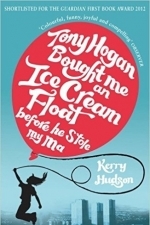Search
Search results

And Justice For Some: An Expose of the Lawyers and Judges Who Let Dangerous Criminals Go
Book
FULLY REVISED EDITION CONTAINING NEVER-BEFORE PUBLISHED FACTS ABOUT THE JONBENET RAMSEY CASE, and...
Eilidh G Clark (177 KP) rated Tony Hogan Bought Me an Ice Cream Float Before He Stole My Ma in Books
May 14, 2017
This is not only a well-written novel but also a powerful commentary on life within the poverty trap.
‘Graffiti and scorch marks, echoes of small fires, decorated doorsteps. Golden Special Brew cans and crushed vodka bottles, bright as diamonds, collected in gutters. Front gardens were filled with mouldy paddling pools and, occasionally, a rust burnished shell of a car. I had never seen anything so beautiful, so many colours, before in grey Aberdeen.’
This is a novel with nothing held back. While the title is light hearted and the cover art bright and cheerful, both are deceiving. The cover shows a silhouette of a young girl holding a giant red balloon against the backdrop of a Scottish suburban town. It is important to address the significance of this image. Readers may recall a similar painting by Banksy, named Girl With Balloon which was originally painted on a wall in London. Beside the painting was engraved “There Is Always Hope”. While Banksy’s painting shows the girl releasing the balloon, possibly representing lost hope or lost innocence, Hudson’s cover shows the girl being lifted by the balloon. Considering this when addressing the text, it is clear that Hudson wished to demonstrate that one can only hold on to hope by not letting go. Critics have described this book as containing bittersweet humour and Hudson cleverly intrudes in the second chapter by saying that this is in fact a ‘humorous cautionary tale’. As soon as you begin reading, expect to get dirt under your nails. The author launches right into the location of the novel using regional Scottish dialect and local Aberdonian vernacular. The story begins with the birth of out protagonist, Janie Ryan. Born to Iris (formally Irene), a single, homeless mother who comes from a line of women described as ‘fishwives to the marrow’, Iris has recently returned from London after trying to change her destiny (not wanting to become her mother). After falling pregnant to a rich and married American man, the relationship breaks down. Iris is forced to return to poverty in the back streets of Aberdeen but is keen to ensure that things have changed,’ I didnae go all the way to fuckin’ London to come back an’ be the same old Irene!’ Unfortunately, Iris falls back into her old ways and for Janie; this has a direct effect on her life. The reader follows the protagonist from her first home to temporary care and then to a string of homes over the UK in some of its poorest areas. Janie watches, as her mother gets involved in some abusive relationships, including one with alcohol, and watches helplessly as her mother loses hope. Towards the latter end of the novel, it is clear that Janie is falling into the same habits as her mother, however, a string of unfortunate event forces her to reassess her life. The end of the novel, like the cover art, is left to the reader’s interpretation. Can Janie break the cycle and make changes to her life, or is she destined to become her mother? This is not only a well-written novel but also a powerful commentary on life within the poverty trap.
Kerry Hudson, Tony Hogan Bought me an Ice Cream Float Before He Stole My Ma, 2012 published by Vintage Books
This is a novel with nothing held back. While the title is light hearted and the cover art bright and cheerful, both are deceiving. The cover shows a silhouette of a young girl holding a giant red balloon against the backdrop of a Scottish suburban town. It is important to address the significance of this image. Readers may recall a similar painting by Banksy, named Girl With Balloon which was originally painted on a wall in London. Beside the painting was engraved “There Is Always Hope”. While Banksy’s painting shows the girl releasing the balloon, possibly representing lost hope or lost innocence, Hudson’s cover shows the girl being lifted by the balloon. Considering this when addressing the text, it is clear that Hudson wished to demonstrate that one can only hold on to hope by not letting go. Critics have described this book as containing bittersweet humour and Hudson cleverly intrudes in the second chapter by saying that this is in fact a ‘humorous cautionary tale’. As soon as you begin reading, expect to get dirt under your nails. The author launches right into the location of the novel using regional Scottish dialect and local Aberdonian vernacular. The story begins with the birth of out protagonist, Janie Ryan. Born to Iris (formally Irene), a single, homeless mother who comes from a line of women described as ‘fishwives to the marrow’, Iris has recently returned from London after trying to change her destiny (not wanting to become her mother). After falling pregnant to a rich and married American man, the relationship breaks down. Iris is forced to return to poverty in the back streets of Aberdeen but is keen to ensure that things have changed,’ I didnae go all the way to fuckin’ London to come back an’ be the same old Irene!’ Unfortunately, Iris falls back into her old ways and for Janie; this has a direct effect on her life. The reader follows the protagonist from her first home to temporary care and then to a string of homes over the UK in some of its poorest areas. Janie watches, as her mother gets involved in some abusive relationships, including one with alcohol, and watches helplessly as her mother loses hope. Towards the latter end of the novel, it is clear that Janie is falling into the same habits as her mother, however, a string of unfortunate event forces her to reassess her life. The end of the novel, like the cover art, is left to the reader’s interpretation. Can Janie break the cycle and make changes to her life, or is she destined to become her mother? This is not only a well-written novel but also a powerful commentary on life within the poverty trap.
Kerry Hudson, Tony Hogan Bought me an Ice Cream Float Before He Stole My Ma, 2012 published by Vintage Books
Movie Metropolis (309 KP) rated Allegiant (2016) in Movies
Jun 11, 2019
A+ for effort
I think it’s probably fair to say that the Young Adult genre has become oversaturated due to the phenomenal success of The Hunger Games. Since coming to a slightly underwhelming conclusion last year, many new franchises have its crown firmly in their sights.
The Maze Runner was a muddled first outing with the second, Scorch Trials faring much better and the same can be said for the Divergent series. The first film was at times, an incomprehensible mess, while its follow-up, Insurgent was a thrilling if CGI-heavy and overlong affair.
Allegiant marks the first of two films ending the moderately successful series, with Ascendant being released in June next year. But does this split conclusion harm it as much as it did for Mockingjay?
Allegiant picks up immediately after the end of its predecessor with Tris Prior (Shailene Woodley), her lover Four (Theo James) and a group of friends leaving their once safe-haven of a post-apocalyptic Chicago in order to find a world beyond the wall, populated by others once thought forgotten. What ensues will change their lives forever.
The cast is on form in this instalment with Woodley growing into the role perfectly. It’s true that she’s no Jennifer Lawrence, and many would see her as a budget Katniss Everdeen, but she plays the character with a confidence only matched by her rival in the genre. Theo James gets a much larger role here too, and this is welcome, given his pivotal part in the novels.
Elsewhere, Naomi Watts does her best Julianne Moore impression and clearly watched the latter’s performance in Mockingjay to prepare for an incredibly similar role. Jeff Daniels is a nice addition as the Bureau of Genetic Welfare’s leader, David, though again, his acting prowess feels a little wasted.
Robert Schwentke directs the film with a unique colour palate and visual flair. Scenes “beyond the wall” are stunning and glisten with a red lick of paint, a welcome change from the staid, grey and blue many directors continue to use in blockbusters. It’s very Total Recall-esque in these sequences and better for it.
Unfortunately, once the plucky group of teens leave the Martian-like “Fringe” behind, the CGI kicks up a gear. This is where things start to unravel somewhat and Schwentke throws effect upon effect at the screen until there is hardly any realism left. On the whole, they’re pretty decent, but there are a few lapses that stop the film dead in its tracks, especially towards the cliff-hanger conclusion.
It’s also far too long. Much like Mockingjay, splitting the final book was an exercise in cash-grabbing rather than giving fans of the novels what they want. At over two hours in length, Allegiant drags in places and means the final film, as a whole, will be around four hours.
Nevertheless, there is much to enjoy here. The story for newcomers is incomprehensible and some of the dialogue is downright laughable, but for those of us continuing the saga, it’s an epic adventure with some cracking visuals, good acting and an intriguing plot – despite a few convoluted moments.
Overall, Allegiant is a film hampered by its timing. The similarities to The Hunger Games are obvious throughout, from exactly the same dialogue in certain scenes, to similar sets and similar casting decisions. But, if you can forget all that, it’s a fun, if overlong ride
https://moviemetropolis.net/2016/03/13/a-for-effort-divergent-allegiant-review/
The Maze Runner was a muddled first outing with the second, Scorch Trials faring much better and the same can be said for the Divergent series. The first film was at times, an incomprehensible mess, while its follow-up, Insurgent was a thrilling if CGI-heavy and overlong affair.
Allegiant marks the first of two films ending the moderately successful series, with Ascendant being released in June next year. But does this split conclusion harm it as much as it did for Mockingjay?
Allegiant picks up immediately after the end of its predecessor with Tris Prior (Shailene Woodley), her lover Four (Theo James) and a group of friends leaving their once safe-haven of a post-apocalyptic Chicago in order to find a world beyond the wall, populated by others once thought forgotten. What ensues will change their lives forever.
The cast is on form in this instalment with Woodley growing into the role perfectly. It’s true that she’s no Jennifer Lawrence, and many would see her as a budget Katniss Everdeen, but she plays the character with a confidence only matched by her rival in the genre. Theo James gets a much larger role here too, and this is welcome, given his pivotal part in the novels.
Elsewhere, Naomi Watts does her best Julianne Moore impression and clearly watched the latter’s performance in Mockingjay to prepare for an incredibly similar role. Jeff Daniels is a nice addition as the Bureau of Genetic Welfare’s leader, David, though again, his acting prowess feels a little wasted.
Robert Schwentke directs the film with a unique colour palate and visual flair. Scenes “beyond the wall” are stunning and glisten with a red lick of paint, a welcome change from the staid, grey and blue many directors continue to use in blockbusters. It’s very Total Recall-esque in these sequences and better for it.
Unfortunately, once the plucky group of teens leave the Martian-like “Fringe” behind, the CGI kicks up a gear. This is where things start to unravel somewhat and Schwentke throws effect upon effect at the screen until there is hardly any realism left. On the whole, they’re pretty decent, but there are a few lapses that stop the film dead in its tracks, especially towards the cliff-hanger conclusion.
It’s also far too long. Much like Mockingjay, splitting the final book was an exercise in cash-grabbing rather than giving fans of the novels what they want. At over two hours in length, Allegiant drags in places and means the final film, as a whole, will be around four hours.
Nevertheless, there is much to enjoy here. The story for newcomers is incomprehensible and some of the dialogue is downright laughable, but for those of us continuing the saga, it’s an epic adventure with some cracking visuals, good acting and an intriguing plot – despite a few convoluted moments.
Overall, Allegiant is a film hampered by its timing. The similarities to The Hunger Games are obvious throughout, from exactly the same dialogue in certain scenes, to similar sets and similar casting decisions. But, if you can forget all that, it’s a fun, if overlong ride
https://moviemetropolis.net/2016/03/13/a-for-effort-divergent-allegiant-review/


